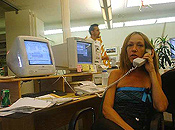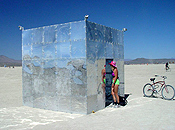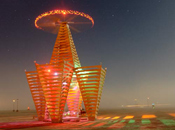The Artery is the Burning Man Art Team.
What the Artery DOES: Serve and defend the artistic expression at Burning Man. Provide an artist resource center that facilitates the placement and display of art on the open playa.
What the Artery does NOT do: We do not tell you what you should create. We don’t rate or rank or rankle your art.
Art Questionnaire and Submissions
With playa dust still in our brains and winter in the air, we look at the past accomplishments, future challenges. And we ask: What must change to allow the Artery to grow and mature into a better cohesive team? If we do not learn from the past, we risk making the same mistakes.
The process of facilitating placement of playa art starts shortly after we return from the event. Always, we return to the work of refining the questions asked of anyone creating art for public display at Burning Man. We ask so that we may know how to help with placement and safety for those creating art. Every question is asked for a reason.
The teams for Art, theme camp placement, and the Department of Mutant Vehicles (DMV) cooperated in developing the questionnaire for 2004. Effort was intensified to incorporate the standard flame classifications from the art questionnaires into the theme camp and DMV questionnaires. For the first time, the three different teams spoke the same language in determining flame classifications. The Performance Safety Team (PST), which maintains oversight of all art that incorporates fire, flame effects, or pyrotechnics, is responsible for this major shift in communication.
Major changes to the art questionnaires for the 2003 event were refined or left unchanged in 2004. The PST found people still confused about the designations for open flame and flame effects. In the future, we will keep working to refine the questions in a way that pulls the correct answers from artists.
 We work hard to gather information to help us facilitate the exciting prospect of creating art for the playa. We talk a lot about how to ask an intelligent question that elicits the correct information, without being condescending. As a result of these discussions, the art questionnaire continues to be refined with each years event. As the art changes and evolves, so do the questions.
We work hard to gather information to help us facilitate the exciting prospect of creating art for the playa. We talk a lot about how to ask an intelligent question that elicits the correct information, without being condescending. As a result of these discussions, the art questionnaire continues to be refined with each years event. As the art changes and evolves, so do the questions.
As information accumulates, preparation for the playa begins.
Placement and Playa Preparations
 Planning is a different process from mapping the placement, and this essential distinction helps artists and others to understand our process. The city layout for Black Rock City begins as a plan printed on paper. The plan becomes reality when the last fence post is hammered into the desert floor, and Black Rock City begins to change from a map to a living, breathing metropolis. Until then, the pre-event team maintains ongoing communication with all artists who fill out our questionnaire. The answers to the teams outreach set in motion our preparations for our shared time on the playa. Additional teams within the Art department, including Art Support Services and the Performance Safety Team, assist artists with their needs. Most installations are given a spot on the plan, ensuring that each artwork has adequate space to avoid sound and light interference and to ensure fire safety. This planning saves time on the playa, since preparations ahead of time free the Artery team to deal with last-minute stuff.
Planning is a different process from mapping the placement, and this essential distinction helps artists and others to understand our process. The city layout for Black Rock City begins as a plan printed on paper. The plan becomes reality when the last fence post is hammered into the desert floor, and Black Rock City begins to change from a map to a living, breathing metropolis. Until then, the pre-event team maintains ongoing communication with all artists who fill out our questionnaire. The answers to the teams outreach set in motion our preparations for our shared time on the playa. Additional teams within the Art department, including Art Support Services and the Performance Safety Team, assist artists with their needs. Most installations are given a spot on the plan, ensuring that each artwork has adequate space to avoid sound and light interference and to ensure fire safety. This planning saves time on the playa, since preparations ahead of time free the Artery team to deal with last-minute stuff.
Preparations for the playa require that we close submissions to the art questionnaire, which usually happens on August 1. We found that this date left us without enough time for our preparations. This date will change to improve the teams preparations for the desert, including relocating our operations. Artists can continue to create art for display at Burning Man, though. Participants can simply print the questionnaire and fill in the information, then bring it to the desert with their artwork. These unregistered projects are called “walk-ins”.
For the third year in a row, the team has used Global Positioning System (GPS) units to define the spots where art will go on the playa. This technology cuts down the time required to find where art should go and to escort artists to their spots. The process was slowed down during 2004, because the GPS units arrived late on the playa. This will change in 2005.
Playa Time: Artist Registration
The Art departments playa headquarters in Center Camp functions as a check-in center for artists, as well as a hub for information about their art. Art registration begins and ends with the team. Whether the artist has registered ahead of time or simply walks into the playa headquarters, were there to help. Our simple checklist of essential information helps to maintain the high standards of creating safe art at Burning Man. High standards are our paramount goal – always have been, and always will be. Guidelines include:
- Adequately lighting artwork, because the playa can be a very dark environment, and the artist does not want to lose their work by a vehicle or bicycle running into it.
- Leave No Trace, which means that the artwork will not leave litter and that the playa will be protected, so that the only thing left behind will be the great memories that the art gave to participants.
- Safely playing with fire, which ensures that the artist understands and accepts the responsibility of introducing any potentially dangerous art.
 Some artists like to see their work standing along the bustling Esplanade, while others prefer the serenity of the outer playa. Some folks come with a burn plan, while others are unaware that they need one. The Artery steers all artists through the guidelines, and once artists have fully registered, we escort them to their playa locations. The Artery is constantly filled with artists and other visitors. Some come to ask for our help, and some simply enjoy the lively atmosphere under our shade structure. Other folks come hoping to learn more about the art installations.
Some artists like to see their work standing along the bustling Esplanade, while others prefer the serenity of the outer playa. Some folks come with a burn plan, while others are unaware that they need one. The Artery steers all artists through the guidelines, and once artists have fully registered, we escort them to their playa locations. The Artery is constantly filled with artists and other visitors. Some come to ask for our help, and some simply enjoy the lively atmosphere under our shade structure. Other folks come hoping to learn more about the art installations.
One wall of our playa headquarters displays a large map that diagrams the locations of art installations. An informal art gallery on the other walls features drawings and plans of the art installations on the open playa. We have binders of additional information gathered throughout the year from art registrations and other contacts with artists.
The Artery also serves as a drop-off point for contributions to the Material Culture archive. We accept and document contributions, then store them through the event. Afterward, we catalog contributions for eventual posting on the Burning Man web site.
Artery staff (displaying their own expressive costumes, of course) also direct driving tours of the art installations. We have an amazing bus, the Empyrean Cruiser, dedicated to leading tours twice daily, with a special fire art tour on Friday. For those who prefer to take the tour on their own timetable, the team also printed self-tour guides in 2004.
Artery Positions
The Artery team blossomed again during 2004. New positions were created to help the art process flow more efficiently than in previous years and to eliminate the stress of some team members doing too much work:
- “Dispatch” maintains an overall view of everything happening with the art process, directing information over radios, making note of recorded GPS waypoints, and troubleshooting problems.
- “Concierges” help arriving artists to check in and ensures accuracy in recorded locations.
- “Greeters” manage the traffic flow through the Artery, directing participants and answering questions.
These three positions were a great addition to the success of the team.
Goals for 2005
The Artery has many goals:
- As a way to empower the Artery team to take the next leap, an Art Council will be created. All members will assume more responsibility and have more of a stake in the final outcome.
- We will begin a mentoring program for artists.
- On-playa information will explain why our guidelines are in place.
- We will find new ways to let artists and their audiences know how much we appreciate everyones participation.
Does art generate community or does community generate art? We don’t have all the answers. But we help you find the pieces. And we feed the process.
Submitted by,
Crimson Rose and Debbie Rich

